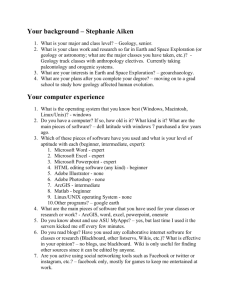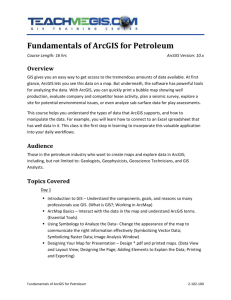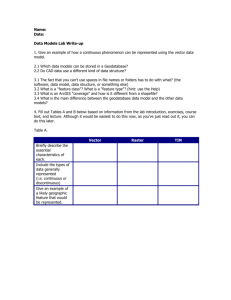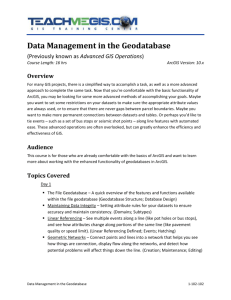Lecture22010
advertisement
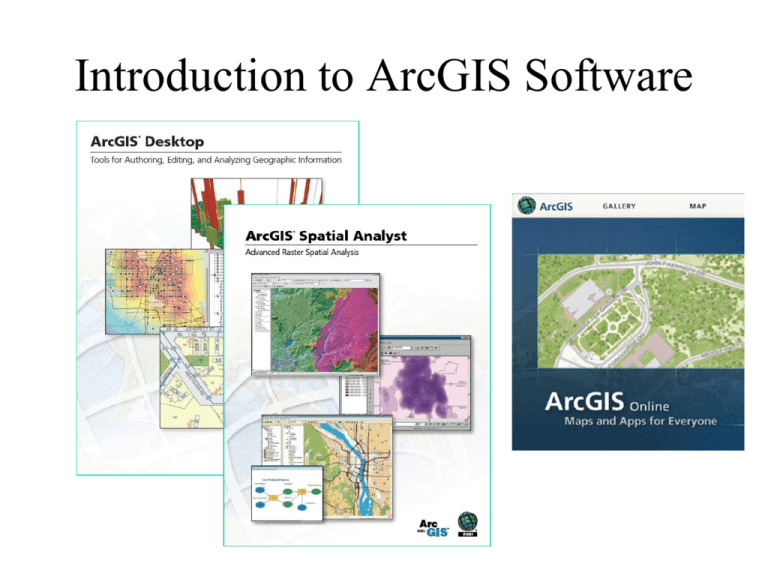
Introduction to ArcGIS Software ESRI Online Reference Materials • ArcGIS summary: http://www.esri.com/library/brochures/pdfs/arcgis. pdf • ArcGIS Desktop summary: http://www.esri.com/library/brochures/pdfs/arcgisdesktop.pdf • Spatial Analyst summary: http://www.esri.com/library/brochures/pdfs/spatial analystbro.pdf • ESRI Virtual Campus – provides online training http://campus.esri.com/ The first three items are readings for this class ArcGIS Online http://www.argis.com • Description: http://www.esri.com/software/arcgis/arcgisonl ine/index.html • Videos: http://www.esri.com/software/arcgis/arcgisonl ine/demos.html Please familiarize yourself with this information Introduction to GIS Software • How data are stored in ArcGIS • Components of ArcGIS – ArcMap, ArcCatalog and ArcToolbox • GIS on the Web – ArcGIS Server, ArcGIS Online, Google Earth. • Extensions of ArcGIS – spatial analyst, geostatistical analyst and 3D analyst ESRI GIS Development Arc/Info (coverage model) Versions 1-7 from 1980 – 1999 Arc Macro Language (AML) 160,000 licenses 1,200,000 users as of 2009 ArcGIS (geodatabase model) Version 8.0, …, 10.0 from 2000 – Python scripting ArcView (shapefile model) Versions 1-3 from 1994 – 1999 Avenue scripting language Geographic Data Models All geographic information systems are built using formal models that describe how things are located in space. A formal model is an abstract and well-defined system of concepts. A geographic data model defines the vocabulary for describing and reasoning about the things that are located on the earth. Geographic data models serve as the foundation on which all geographic information systems are built. Scott Morehouse, Preface to “Modeling our World” Data Models • A geographic data model is a structure for organizing geospatial data so that it can be easily stored and retrieved. Geographic coordinates Tabular attributes File-based Data Models Geographic coordinates and attributes are stored in separate but linked files Arc • Coverages – Developed for workstation Arc/Info ~ 1980 – Complex structure, proprietary format – Attributes in Info tables Info • Shapefiles – Developed for ArcView ~ 1993 – Simpler structure in public domain – Attributes in dBase (.dbf) tables Storing Data Coverages Shapefiles Texas Texas Counties Counties.shp Counties.shx Evap Counties.dbf Evap.shp Evap.shx Info Evap.dbf Storing Data • Coverages and Shapefiles – Coverages are stored partially in their own folder (ARC) and partially in the common INFO folder. Shapefiles are stored in three to five files (with extensions .shp, .shx, .dbf, .sbx and .sbn). – Coverages store common boundaries between polygons only once, to avoid redundancy. Shapefiles store all the geometry of each polygon regardless of redundancy. – Coverage features are single lines or single polygons. Shapefiles allow features to have multiple, disconnected, intersecting and overlapping components. Geodatabase and Feature Dataset • A geodatabase is a relational database that stores geographic information. • A feature dataset is a collection of feature classes that share the same spatial reference frame. Geodatabase model • Stores geographic coordinates as one attribute (shape) in a relational database table • Uses MS Access for “Personal Shape Geodatabase” (single user) • Uses Oracle, SQL/Server, dB2 or other commercial relational databases for “Enterprise Geodatabases” (many simultaneous users) • Uses files in “File Geodatabase” ArcGIS Geodatabase Workspace Geodatabase Feature Dataset Feature Class Geometric Network Relationship Object Class Object Class • An object class is a collection of objects in tabular format that have the same behavior and the same attributes. An object class is a table that has a unique identifier (ObjectID) for each record Feature Class • A feature class is a collection of geographic objects in tabular format that have the same behavior and the same attributes. Feature Class = Object class + spatial coordinates Relationship • A relationship is an association or link between two objects in a database. • A relationship can exist between spatial objects (features in feature classes), nonspatial objects (objects in object classes), or between spatial and non-spatial objects. Relationship Relationship between non-spatial objects Water Quality Data Water Quality Parameters Relationship Relationship between spatial and non-spatial objects Water quality data (non-spatial) Measurement station (spatial) Network • A network is a set of edges (lines) and junctions (points) that are topologically connected to each other. • Each edge knows which junctions are at its endpoints • Each junction knows which edges it connects to Introduction to GIS Software • How data are stored in ArcGIS • Components of ArcGIS – ArcMap, ArcCatalog and ArcToolbox • GIS on the Web – ArcGIS Server, ArcGIS Online. • Extensions of ArcGIS – spatial analyst, geostatistical analyst and 3D analyst Arc Map View and edit data Create maps Analyze data (Geoprocessing) Graphical previews View data (like Windows Explorer) Arc Catalog Tables Metadata Arc Toolbox Tools for commonly used tasks Map Projections Geo-Processing Toolbox tools linked together using the model builder to automate data processing Levels of ArcGIS • ArcView – View data and do edits on shape files and simple personal geodatabases • ArcEditor – do more complex edits on enterprise geodatabases • ArcInfo – the full system, with access to workstation ArcInfo (i.e. ArcInfo version 7) as well License manager The license manager keeps track of number of simultaneous users and limits them to allowable number. If you can’t get an available license in LRC, ask the proctor to restart the ArcGIS license manager. At USU contact Paul Rew to get the license manager restarted paul.rew@usu.edu. At UNL Jim Hines (4726708, jhines2@unl.edu ) or Gregg Hutchison (472-5436) at room 226 is the contact person to restart the ArcGIS license manager. Introduction to GIS Software • How data are stored in ArcGIS • Components of ArcGIS – ArcMap, ArcCatalog and ArcToolbox • GIS on the Web – ArcGIS Server, ArcGIS Online, Google Earth. • Extensions of ArcGIS – spatial analyst, geostatistical analyst and 3D analyst Desktop, Server, Web Desktop GIS ArcGIS Desktop ArcGIS Server CRWR Data Services http://data.crwr.utexas.edu Receiving Service in ArcCatalog Publishing Service in ArcGIS Server Workstation-centered GIS Web ArcGIS Desktop Local Enterprise Next 4 slides from Scott Morehouse, ESRI Enterprise-centered GIS ArcGIS Server Web-centered GIS ArcGIS Online An Integrated Systems Approach ArcGIS Online ArcGIS ArcGIS Desktop Server Multiscale Tiled Images Small Scale: Little detail, broad coverage 1:1,000,000 Large Scale: Great detail, narrow coverage 1:1,000 World Topographic Base Map Cartographic map built from GIS data With content added by the City of Austin Bing Maps in ArcGIS.com Google Earth Geographic Web Browser http://earth.google.com/ Google Earth 3D With Terrain Adding data to Google Earth Experimental Watershed Data http://watershed.montana.edu/ICEWATER/ Observations Data and Google Earth http://odm.usu.edu/odmmap/default.aspx?NetworkName=Little Bear River Introduction to GIS Software • How data are stored in ArcGIS • Components of ArcGIS – ArcMap, ArcCatalog and ArcToolbox • GIS on the Web – ArcGIS Server, ArcGIS Online, Google Earth. • Extensions of ArcGIS – spatial analyst, geostatistical analyst and 3D analyst ArcGIS Extensions Spatial Analyst • Analysis of land surface terrain as a grid • Key means of defining drainage areas and connectivity to stream network Grid Datasets • Cellular-based data structure composed of square cells of equal size arranged in rows and columns. • The grid cell size and extension (number of rows and columns), as well as the value at each cell have to be stored as part of the grid definition. Number of rows Number of columns Cell size Grid Datasets • Grid datasets Geostatistical Analyst • Interpolation of points to a grid using statistical correlation • Produces a standard error of estimate of each map location Siberia Alaska Biomass in the Arctic Ocean Image Datasets Digital Orthophotos and satellite imagery • Image datasets Image Datasets • Supported image formats: – ARC Digitized Raster Graphics (ADRG) – Windows bitmap images (BMP) [.bmp] – Multiband (BSQ, BIL and BIP) and single band images [.bsq, .bil and .bip] – ERDAS [.lan and .gis] – ESRI Grid datasets – IMAGINE [.img] – IMPELL Bitmaps [.rlc] – Image catalogs – JPEG [.jpg] – MrSID [.sid] – National Image Transfer Format (NITF) – Sun rasterfiles [.rs, .ras and .sun] – Tag Image File Format (TIFF) [.tiff, .tif and .tff] – TIFF/LZW 3-D Analyst • Analysis of land surface terrain as triangulated irregular network (TIN) • Visualization in 3-D using Arc Scene Stream channel of Pecan Bayou, TX TIN Datasets • TIN datasets Points and breaklines from which a TIN is constructed. TIN Datasets • Triangle sides are constructed by connecting adjacent points so that the minimum angle of each triangle is maximized. Triangle sides cannot cross breaklines. • The TIN format is efficient to store data because the resolution adjusts to the parameter spatial variability. Multipatch features 3D surfaces as collections of triangles Tracking Analyst Produces animated maps and display files for space-time data Summary (1) • Three core data representations for vector data: coverage (ArcInfo), shapefile (ArcView) and geodatabase (ArcGIS). We will emphasize geodatabase in this class • Relationships based on attributes (table fields) or on geometry (networks) are used to connect related geographic features Summary (2) • ArcGIS Components: ArcMap, ArcCatalog, ArcToolbox • ArcGIS levels: ArcInfo, ArcEditor, ArcView • Desktop, Server and Web-based sources of maps and data • ArcGIS Online – image maps and shared data content Summary (3) • Google Earth – web-based GIS and KML addons • ArcGIS Extensions: Spatial Analyst, 3D Analyst, Geostatistical Analyst, Tracking Analyst
